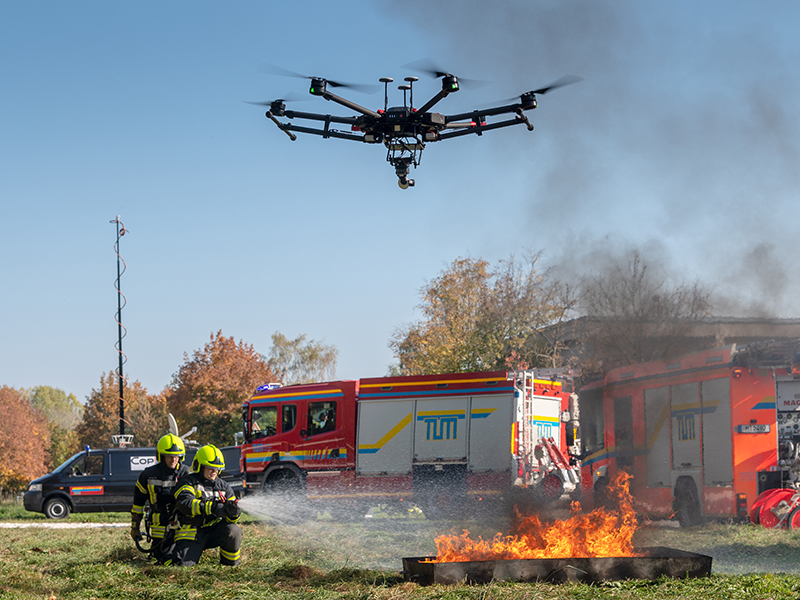Project CopKa: Real-time images for better coordination of emergency responders
Satellites and multicopters support emergency response teams

When responders arrive at the scene of an accident, they have to form an accurate picture of the situation as quickly as possible: Within a matter of only a few minutes the mission commander makes important decisions which will determine the further course of the rescue mission, for example whether or not to call in additional personnel or equipment and who is to take on what assignment.
"It can be difficult to quickly get a complete picture of the situation, especially when the mission is spread across a large area," explains Michael Reffgen of the TUM campus fire department in Garching. In the project "CopKa" TUM scientists worked together with the campus fire department to develop a system that collects additional information.
A multicopter makes video images using a camera, and a satellite link then guarantees a reliable transmission to the internet. The aerial shots thus provide a general overview of the situation. This way for example injured victims who have left the site of the incident can be located and vehicles otherwise hidden behind obstacles become visible.
Reliable communication
Transmitting the pictures and videos and maintaining radio contact with the copter involves large amounts of data. Theoretically, mobile communications networks could be used for this data traffic. "But the networks are often operating at full capacity, especially in the vicinity of the accident or fire, since all the people on the scene are of course trying to reach their families and friends," explains Sabine Letschnik of the TUM Chair for Astronautics. The solution: a satellite link. Here it is possible to purchase data volume which does not need to be shared with anyone. Then the data can be transmitted using this reliable connection to any place desired. "It's conceivable that in case of an accident involving a hazardous materials transport, images can be sent to an expert who just happens to be in another country at the time," says Letschnik.
The important factor for the emergency responders is that it is not necessary to dedicate a member of the rescue team to operate the equipment. This means the satellite dish should point itself towards the satellite very quickly and, more than anything, completely automatically. The researchers installed and calibrated position sensors for this purpose. Here it is important that the sensors adapt to local circumstances, for example depending on whether the vehicle carrying the satellite dish is standing on a slope or on flat ground. Large buildings may also interfere with the establishment of the connection.
Copter will identify obstacles
After three years the first phase of the project was successfully completed with a large practical demonstration in October 2018. The researchers as well as the fire department were able to show that the system works. "The technology gives us an enormous advantage in terms of fast information," Reffgen explains. "And that makes it possible for example to call in backup personnel as early as possible."
In the second phase of the project the system will be further improved and stabilized. One goal is for the copter to take off automatically and fly over the mission location, while being able to detect and avoid obstacles. "We want to optimize the system in such a way that it can be used as standard equipment," says Letschnik. In the future every fire-fighting vehicle could be equipped with the copter, a terminal and a small satellite dish.
About CopKa:
"Technology development for interactive support for mission control involving a copter and Ka band satcom link," or CopKa, is a research project of the Technical University of Munich and IMST GmbH with the project partners LSE Space GmbH and TV1 GmbH. The project is receiving funding from the German Federal Ministry for Economic Affairs and Energy; the project principal is the German Aerospace Center, e.V. (DLR), department of aeronautical management / satellite communication.
Contact:
Dipl.-Ing. Sabine Letschnik
Technical University of Munich
Chair for Astronautics
Tel: +49 (0) 89 289 16019
Mobil: +49 (0) 176 25123831
Mail: s.letschnik@tum.de
Michael Reffgen
Technical University of Munich
Garching Campus Fire Department
Tel: +49 (0) 89 289 14617
Mail: michael.reffgen@feuerwehr.tum.de